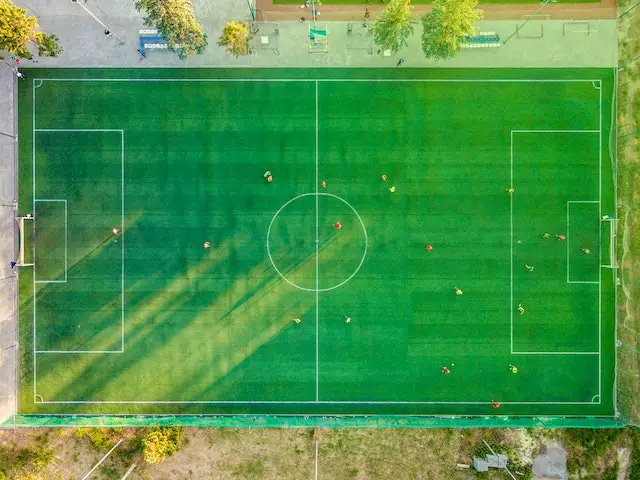Why is a soccer field called a pitch? In the world of soccer, the term “pitch” might leave you wondering. Why not just call it a field?
Let’s unravel this intriguing puzzle and dive into why a soccer field is called a pitch.
Evolution of Soccer Field Terminology
The word “pitch” has an interesting origin in soccer. It dates back to the early days of the sport, when matches were played on a variety of surfaces. These surfaces weren’t always the well-manicured fields we see today. Instead, they ranged from rough grounds to grassy patches.
The term “pitch” was borrowed from the world of cricket and other sports. In those games, a pitch referred to the area where the action happened. When soccer emerged as a sport played on similar grounds, the word “pitch” tagged along.
As soccer evolved, the term “pitch” stuck around. Even as fields became more standardized and well-maintained, the old terminology remained.
The Pitch vs. Field: Semantic Significance
The choice between “pitch” and “field” might seem small, but it holds a deeper meaning in soccer’s world.
“Pitch” brings a sense of action and purpose. It’s where players create magic, fans cheer, and history unfolds. It’s not just a piece of land; it’s a stage for drama.
“Field,” on the other hand, hints at a broader expanse. It’s a canvas where the game plays out, but it might lack the intensity that “pitch” carries.
By using “pitch,” soccer taps into the energy and passion that make the sport unique. It’s not just a surface – it’s a platform for dreams and moments that last.
Early Soccer and Pitches: Tracing the Roots
Back in the beginning of soccer, things were different. Hence, the term “pitch” fits the landscape of the game.
Matches weren’t always on fancy fields. They happened in open spaces, often uneven and rugged. These early soccer “pitches” were more like improvised arenas, with minimal markings and maximal passion.
Players dashed and dribbled on whatever ground was available, making do with what they had. These humble pitches saw the birth of the sport’s essence.
Over time, as soccer grew and rules solidified, the pitches started to transform. Lines were drawn, measurements standardized, and the game’s home evolved into modern fields.
But the term “pitch” kept its place, reminding us of soccer’s humble origins and the raw spirit of those early matches. It’s a nod to where we started and how far we’ve come.
Pitch Construction and Characteristics
Building a soccer pitch involves more than just marking some lines. Let’s explore the process and key features that define a soccer pitch.
- Layout and Dimensions:
- Soccer pitches have standardized dimensions set by governing bodies like FIFA.
- Length typically ranges from 100 to 110 meters, and width ranges from 64 to 75 meters.
- Natural Grass vs. Artificial Turf:
- Traditional pitches feature natural grass, requiring meticulous maintenance for optimal playability.
- Artificial turf pitches offer durability and consistent playing conditions but can differ in feel from natural grass.
- Drainage and Irrigation:
- Proper drainage systems prevent waterlogging, ensuring matches can be played even in wet conditions.
- Irrigation systems maintain the health of natural grass, keeping it lush and green.
- Pitch Markings:
- Markings define key areas like the penalty box, center circle, and goal area.
- White lines contrast with the pitch, aiding players and referees in making accurate decisions.
- Goalposts and Nets:
- Sturdy goalposts with secure net attachments are essential for fair play.
- Pitch Quality and Maintenance:
- Regular mowing, fertilizing, and aeration keep natural grass in top condition.
- Artificial turf requires grooming to maintain its appearance and consistency.
- Player Safety:
- Pitch quality affects player safety, minimizing the risk of injuries from slips and falls.
- Proper maintenance ensures an even playing surface without dangerous divots.
- Innovation and Technology:
- Advancements like hybrid grass systems combine natural and synthetic elements for durability and performance.
- Pitch monitoring technology assesses conditions, enabling timely adjustments for optimal playability.
The Pitches of Other Sports: Cross-Sport Insights
1. Cricket’s Long Stretch: In cricket, the pitch is the strip of ground between the wickets. Bowlers deliver the ball on this area, which can wear down and affect gameplay.
2. Baseball’s Diamond: In baseball, a pitch is when a pitcher throws a baseball toward home plate to begin a play.
3. Rugby’s Green Pitch: A rugby field is also called a pitch. However, while similar in name to soccer, the gameplay and markings differ significantly.
4. Lacrosse’s Playing Area: Lacrosse fields, or pitches, host fast-paced matches where players maneuver to score goals.
Final Thoughts on Why Soccer Field is Called a Pitch
In the world of soccer, a term as simple as “pitch” carries a wealth of history, culture, and linguistic evolution. From the humble patches of the past to the meticulously designed fields of today, the term has traveled across time and continents, connecting fans and players in a universal language.
Thank You For Reading
I hope you enjoyed our article on why a soccer field is called a pitch. If you did, then do consider sharing it with fellow soccer enthusiasts.
Your support and sharing of this content can help us reach a wider audience and provide valuable information to more people who share our passion for the beautiful game.
Thank you for supporting Soccer Mavericks!
If you liked this article, you will love reading:











